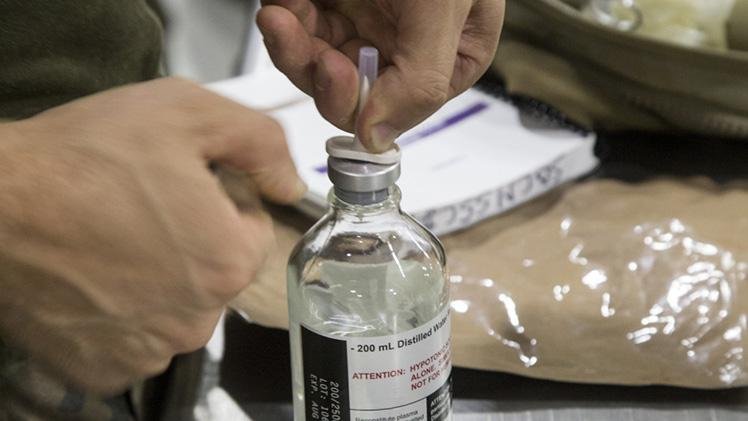A critical skills operators with the U.S. Marine Corps Forces, Special Operations Command trains with freeze-dried plasma. FDP was used for the first time to save a life on the battlefield last month, the Marine Corps reported on Friday. U.S. Marine Corps photo by Sgt. Salvador R. Moreno
Sept. 8 (UPI) -- Freeze-dried plasma has been used for the first time by U.S. Marine Corps Special Operations Command troops to help save a life.
The plasma was used in battlefield trauma care in the Central Command area of operations when an allied soldier received life-threatening injuries, the Marines said.
"I think it reassures Raiders that when they're in harm's way, they have a life-saving product in the medical bags of their very capable corpsmen," U.S. Navy Lt. Eric Green, a force health protection officer, said in a press release.
Green is a study coordinator with MARSOC Health Services Support. He said freeze-dried plasma is a dehydrated version of plasma that replaces the clotting factors lost in blood.
Normal plasma is normally frozen and thawed over a period of five days, preventing quick use in a deployed setting. Equipment such as refrigerators -- and thus the availability of electricity -- is also needed to protect normal plasma.
Freeze-dried plasma, which aids in blood clotting, eliminates the need for freezing and refrigeration because it has a shelf-life of two years.
Green said that before MARSOC received approval to begin use of freeze-dried plasma, battlefield treatment options for hemorrhaging were mainly limited to tourniquets and chemical clotting agents.
Hemorrhaging is considered a major cause of deaths on a battlefield.
"It is stable in the field unlike whole blood or if we were to do fresh plasma or frozen plasma, so our guys can carry it with them in their resuscitative packs," said U.S. Navy Capt. Necia Williams, FDP primary principal investigator and MARSOC force surgeon. "They can quickly reconstitute it, infuse it to somebody and it buys time that is so critical."
U.S. Navy Lt. Aaron Conway, Marine Raider Regiment surgeon with MARSOC HSS, said reconstitution with freeze-dried plasma happens within six minutes.
All MARSOC special amphibious reconnaissance corpsman have been deployed with a supply of freeze-dried plasma since last December. By October, every MARSOC unit deployed will be equipped with FDP.
Freeze-dried plasma is manufactured by the French Centre de Transfusion Sanguine de Armees. They provide the U.S. with FDP.
FDP is awaiting approval from the U.S. Food and Drug Administration. The use of FDP is currently allowed within U.S. Special Operations Command. MARSOC was the second service component within U.S. Special Operations Command to receive approval for its use.















